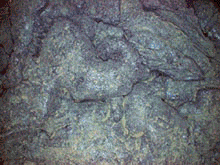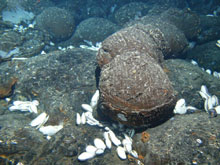
View a slide show of some of the Galápagos Rift marine life collected by scientist diving in the Alvin submersible.
![]() Click image to view a slide show.
Click image to view a slide show.
Submarine eruptions at mid-ocean ridges produce fresh lava flows like these "pillow" lavas, which form as lava slowly oozes out of a fissure on the sea floor. Click image for larger view.
Rosebud Hydrothermal Vents - Galápagos Rift 2005
May 19 - June 3, 2005
Timothy M. Shank
Assistant Scientist, Biology Department
Woods Hole Oceanographic Institution
Daniel J. Fornari
Marine Geologist
Woods Hole Oceanographic Institution
Just over a quarter-century ago, a discovery on the bottom of the eastern Pacific Ocean forever changed our understanding of our planet, and life on it. Thriving at deep-sea vents was a community of tubeworms, giant clams, white crabs, and other species never before seen by people.
The hydrothermal vents and exotic organisms were first found in 1977 at the Galápagos Rift, located on a mid-ocean ridge about 250 miles from the Galápagos Islands. In 2002, researchers diving in the submersible Alvin discovered that sea-floor lava had paved over a hydrothermal vent site called the Rose Garden. The Rose Garden was gone, wiping out large communities of tubeworms, mussels, and other animals living there, but further exploration in Alvin revealed that life still flourished. A few hundred meters away, tiny animals had begun colonizing a new vent field in the aftermath of the volcanic eruption. These animal communities exist in a dark, volcanic undersea valley. Researchers named the new vent site Rosebud, for the young community of sea creatures found living there. This new field is located 2,600 meters (1.6 miles) below the ocean surface and is about 4 kilometers (2.5 miles) wide.
Researchers used the Alvin submersible aboard the RV Atlantis to see how the animal communities have developed and what chemical, microbial and geological changes have occurred. They made detailed maps of the animal distributions, took high-resolution photographs to create photomosaics of the seafloor, sampled the animals and lava flows, as well as deployed time-lapse cameras, larval traps, and chemical sensors directly at the vents. They also searched for new animal communities and black-smoker vents along still unexplored areas of the Galápagos Rift.
Scientist's built on the knowledge gained from previous expeditions to the Rosebud hydrothermal vent community to explore another nearby site called Mussel Bed. It has been 15 years since scientists visited Mussel Bed, and they are eager to see if-and how—the massive colonies of mussels have changed.
Understanding survival in the deep sea
In the 28 years since hydrothermal vents were discovered along mid-ocean ridges, scientists are still puzzled over how tubeworms, clams, mussels, and other organisms populate these deep-sea oases. Tim Shank, a biologist at Woods Hole Oceanographic Institution (WHOI) and the chief scientist for the expedition, calls deep-sea vents “Earth’s largest chemosynthetic community,” where inhabitants live without sunlight. Instead, they use dissolved gases in vent fluids as their energy source.
“There’s no other place on the planet like this, yet we know little about how young organisms colonize, assemble, and form new communities,” he said. So understanding the factors that determine why animal larvae settle there is the first step toward understanding the bigger picture of how sea-floor life has developed across the wide expanse of the ocean, and throughout time.
Teamwork for science
The changes at hydrothermal vents involve many different, interrelated organisms and processes. On an expedition, scientists worked as a team to figure out how vents and vent life interact and operate.
Biologists looked at the ways in which the larger animals at the site, called macrofauna, have evolved over the past three years. After collecting and trapping samples of sea-floor larvae, Tim, Stace Beaulieu and other biologists from WHOI looked at the animals’ genetic composition. They compared this information with genetic data of adult animals from the site.
Chemists used state-of-the-art chemical sensors developed by scientists Bill Seyfried and Kang Ding at the University of Minnesota. Their instruments, which made round-the-clock measurements for the duration of the cruise, assessed some of the key chemical properties of the venting fluids to get a clearer picture of how vent chemistry influenced the larvae’s settlement.
Microbiologists Naomi Ward and Kevin Penn of The Institute for Genomic Research collected microbe samples from rock surfaces and vent animals, and used genetic techniques to identify microbes where vent animals colonize. This information helped them understand the role that microbes play in the evolution of hydrothermal vents.
Geologists collected rocks and made sea-floor maps using observational, photographic, and bathymetric data collected by Alvin. At night, when Alvin resurfaced to charge its batteries, WHOI geologists Dan Fornari, Susan Humphris, and Adam Soule slowly towed a digital deep-sea camera system-the WHOI TowCam-above the sea-floor to map the extent of lava flows. The information helped them to better understand the volcanic and tectonic history of this part of the rift valley and how it relates to hydrothermal venting.
Each day brought new samples, new discoveries, and new ideas about how hydrothermal vents at the Galápagos Rift changed since they were first discovered, and new insights into how life evolved in these extreme environments on the deep-sea floor.
Related Links
Dive and Discover ![]() - Visit for a complete chronicle of this exploration.
- Visit for a complete chronicle of this exploration.


